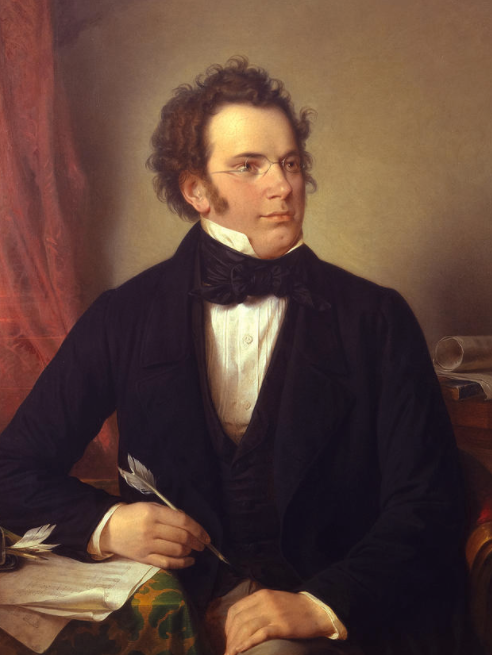Franz Schubert

- Born: January 31, 1971 in Vienna
- Died: November 19, 1828 in Vienna
Symphony No. 8 in B Minor, D. 759, Unfinished
- Composed: 1822
- Premiere: December 17, 1865 in Vienna conducted by Johann von Herbeck
- Instrumentation: 2 flutes, 2 oboes, 2 clarinets, 2 bassoons, 2 horns, 2 trumpets, 3 trombones, timpani, strings
- CSO notable performances: First CSO Performance: February 1895 Anton Seidl conducting. Most Recent Performance: November 2020 live stream only concert Louis Langrée conducting.
- Duration: approx. 25 minutes
Our understanding of the symphonic career of Franz Schubert has changed drastically in the past decade. We used to think that he had completed seven symphonies and left two unfinished, between 1813 and his death in 1828. Now we understand that his seven finished symphonies span the years 1813–1826 and that he also worked on six additional symphonies, all of which he left incomplete.
One of these is the well-known Unfinished in B minor, of which Schubert completed and orchestrated the first two movements. He sketched a scherzo, orchestrated its first two pages and wrote the melody line of a trio. English musicologist Brian Newbould suggests that the B minor entr’acte from the Rosamunde incidental music may have been intended to serve as the finale.
After working on the symphony for about a month in the autumn of 1822, Schubert put it aside in order to compose the well-known Wanderer Fantasy for piano. The following spring, he was made an honorary member of the Styrian Music Society in Graz, one of the few honors he received during his lifetime. He wrote a letter of appreciation to the Society, in which he promised them as a token of his gratitude the manuscript “of one of my symphonies.”
In September Schubert gave the unfinished score of the B Minor Symphony to his close friend Josef Hüttenbrenner, whose brother Anselm was a member of the Society. Anselm was a pianist and a mediocre composer. Apparently there was some misunderstanding, because Anselm never passed the score on to the Society. He kept it without telling anyone for 40 years.
In 1860, 32 years after Schubert’s death, Josef told the conductor Johann Herbeck about the piece. “My brother possesses a treasure in Schubert’s B Minor Symphony, which we place on a level with any of Beethoven’s. Only it isn’t finished. Schubert gave it to me for Anselm as thanks for having sent him, through me, the Diploma of Honor of the Graz Musical Society.” With difficulty Herbeck convinced Anselm, by then an old man, to allow the symphony to be performed. Herbeck had to promise also to perform one of Anselm’s works. The performance of Schubert’s two completed movements took place 43 years after they had been composed.
There has been a lot of speculation on why Schubert never finished the piece and why he never mentioned it, not even to his brother Ferdinand, who was compiling a complete list of Schubert’s works. It has been suggested that the symphony really is complete in two movements. But, if so, why did Schubert sketch a scherzo, and why are the two movements in different keys? Perhaps Schubert simply lost interest in the project. Or perhaps he found he could not write a third movement that lived up to the first two. It has even been proposed that he did in fact complete the work but that the Hüttenbrenners lost half of it.
Inevitably, various people have finished the work. A contest was held on the hundredth anniversary of Schubert’s birth offering a prize for the best completion. The situation is different from that related to, for example, Mozart’s Requiem, Bach’s Art of the Fugue or Mahler’s Tenth Symphony. Schubert did not leave the work unfinished because he died, and he did not leave a large enough portion of the last two movements to allow for simple completion by another hand. Not surprisingly, none of the completions by others has met with wide acceptance.
The Unfinished Symphony contains some of the most beautiful music ever composed, and it surely deserves the popularity it has earned in its two-movement state. Schubert was a supreme lyricist: witness the second theme of the first movement, one of the great tunes of all times. But he had trouble with large forms. He admired the symphonic drama that Beethoven had achieved, but his own development sections tend to be rambling and discursive. His melodic inventiveness all but makes up for this deficiency in most of his extended pieces. The B Minor Symphony, almost uniquely among his compositions, does not suffer from formal weaknesses. It is taut, dramatic and logical. Both its poignant first movement and its bittersweet second are as well integrated and well paced as any of Beethoven’s masterpieces.
The first movement contains a wealth of melodies. Even as the music grows from the depths, it is melodic from the beginning. The first idea, in cellos and basses alone, is destined to become important subsequently. Soon the violins enter with a second melody, followed by a poignantly songful theme in the oboe and clarinet. These three ideas constitute the first theme group. Despite their deep beauty and lyricism, they pale in comparison to the second theme, which begins in the cellos.
The overriding lyricism of the first movement is maintained in the second, which is based on two lovely melodies. The first is heard at the outset in the violins, and the second comes later in the clarinet. The pathos in the second theme is reminiscent of the first movement. The two themes alternate throughout the movement. The coda features a delicately slow-moving line for unaccompanied violins alternating with winds.
—Jonathan D. Kramer